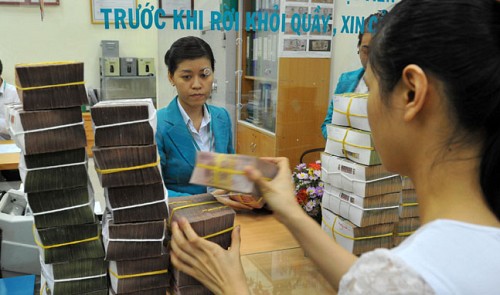With a shabby facade, bars on its windows and flanked by a hair salon and a knockoff clothing store, the Vietnam Asset Management Company (VAMC) looks more like a backstreet pawnshop than a much-heralded bad-debt bank.
This no-frills office with PVC sofas, chintzy 1980s decor and no elevator houses what's been the central bank's shoestring saviour for wayward banks and risky borrowers who ran up $20 billion in bad debt in 2012 and almost brought a promising economy to its knees.
Even as more debts sour at lenders in Southeast Asian neighbours Thailand and Indonesia and also in China, Vietnam's $295 billion banking sector has slashed non-performing loans (NPLs) to 2.9 percent of total loans by September from 17.2 percent in 2012.
VAMC and its 100 staff have, since its July 2013 launch, helped banks get $10 billion in NPLs off their books. In return, banks have received $8.5 billion in special bonds which they can pledge with the central bank to obtain liquidity.
"We save anything that can be salvaged, those that can be profitable over time, we give them time," VAMC chairman Nguyen Quoc Hung told Reuters. "We handle the most frightening NPLs first... and those that can be fixed, we find ways to fix them and help businesses."
The VAMC doesn't actually buy the NPLs but only houses them and helps banks restructure them or sell them off. The risk thus stays with the banks, who must fully write off unrecovered debts over time by making provisions from their annual profits.
How successful VAMC is in disposing of NPLs will determine banks' profit margins. The key to that is expediting sluggish sales of the distressed assets, analysts say.
Can Van Luc, economist and adviser to lender BIDV, said banks are now well-placed to handle debts, but would have to take a hit on profits.
"Banks have to make a sacrifice," he said. "They're lucky they aren't bankrupted or recording net losses."
Supportive economy
Vietnam's bad debt fight has been aided by an economy outperforming much of Asia's, with forecast 6.5 percent growth this year, driven by strong exports, factory output and consumption, and record foreign investment, mostly into manufacturing. Firms are being lured by its looming accession to Pacific and European Union free-trade pacts.
The State Bank of Vietnam (SBV), the central bank, has launched aggressive measures to clean up a fragmented sector of over 40 banks which was blighted by poor oversight, cross-ownership, frivolous state-sector borrowing and widespread fraud that saw tycoons and rogue bankers jailed.
Since 2011, mergers and acquisitions have shrunk 15 lenders into seven, while three banks have been taken over by the SBV.
A healthier economy, a property market rebound and stricter lending have meant fewer loan defaults. Commercial banks have forecast 2015 average profit growth of 9.7 percent and credit growth at a four-year high of 17 percent.
The Thomson Reuters index of Vietnam bank shares has risen 63.2 percent this year, compared to a 7.4 percent fall in the Thomson Reuters Asia-Pacific Banks Index .
The NPL ratio in Indonesia rose to 2.8 percent in August from 2.0 percent in April, while Thai banks' quarterly results last week showed bad debts in the sector climbing, and hitting five-year highs for two banks.
"We've been strict with lending," said Luu Trung Thai, vice chairman of Vietnam's Military Bank, which has trimmed NPLs to 1.8 percent from 2.7 percent nine months ago. "A rebound in real estate has beefed up asset value, hence increased the ability to retrieve assets."
Lingering questions
While banks have rid their books of substantial problem loans, recoveries have been marginal. Only $664 million in NPLs, or 7 percent of the NPLs managed by VAMC, have been restructured or sold.
"There's still the lingering question of how will these NPLs ultimately be resolved and for that there's no clear or easy answer," said Asian Development Bank economist Aaron Batten.
VAMC chairman Hung admits the bad-debt bank is no magic wand, and says formation of a secondary market for poor-quality assets could be the long-term solution.
It's a route taken by China, which is seeing appetite for a $280 billion NPL tide engulfing its banks. Chinese asset management companies are selling high-risk, high-reward assets on the secondary market at heavy discounts.
"VAMC really wants to call for foreign capital ... but it needs adequate mechanisms and legal framework," Hung said. It's unclear how close Vietnam is to establishing a secondary market.
Without a market to sell assets at discounted prices, VAMC won't find it easy to offload collateral it holds, the majority of which is real estate with high book values, analysts said.
"Buyers don't want real estate-backed debts. Prices right now, without a debt market, are just too high," said Nguyen The Minh of Viet Capital Securities.





















































